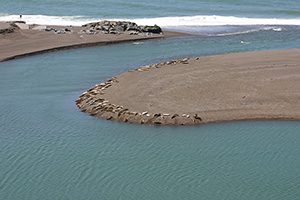Russian River

Russian River – photo copyright David A. Hofmann
The Russian River drains approximately 1,500 square miles of Sonoma and Mendocino counties in Northern California. The estuary is a nursery and particularly important habitat for fish such as young steelhead that use the area to grow and adapt to saltwater before entering the ocean.
Interesting Facts:
- A living laboratory! The Russian River watershed encompasses mountains, valleys, forests, agriculture, cities and towns. All of the water running off of this land makes its way down the 110-mile stretch of the main stem of the Russian River before finally meeting the Pacific Ocean at Jenner, California. Since all the runoff in the watershed makes its way to and through this one spot at Jenner, scientists use the river as a living laboratory to study how our human activities affect the water quality of the ecosystem.
- The Russian River estuary has an incredibly rich biodiversity and provides critical habitat for many species of birds, fish, and other wildlife. Over 50 species of fish have been identified, including Chinook salmon, Tule Perch, Starry Flounder, American Shad and Bay Pipefish.
- The seasonal sandbar provides an important harbor seal haul out and hosts various seabird colonies. The Russian River SMRMA and SMCA protect steelhead and Russian River Chinook and Coho salmon, which aggregate at the mouth of the estuary during seasonal sandbar closures.)
- North of the mouth of the Russian River is Jenner Beach. Goat Rock protrudes into the Pacific at the south end of Goat Rock Beach.


